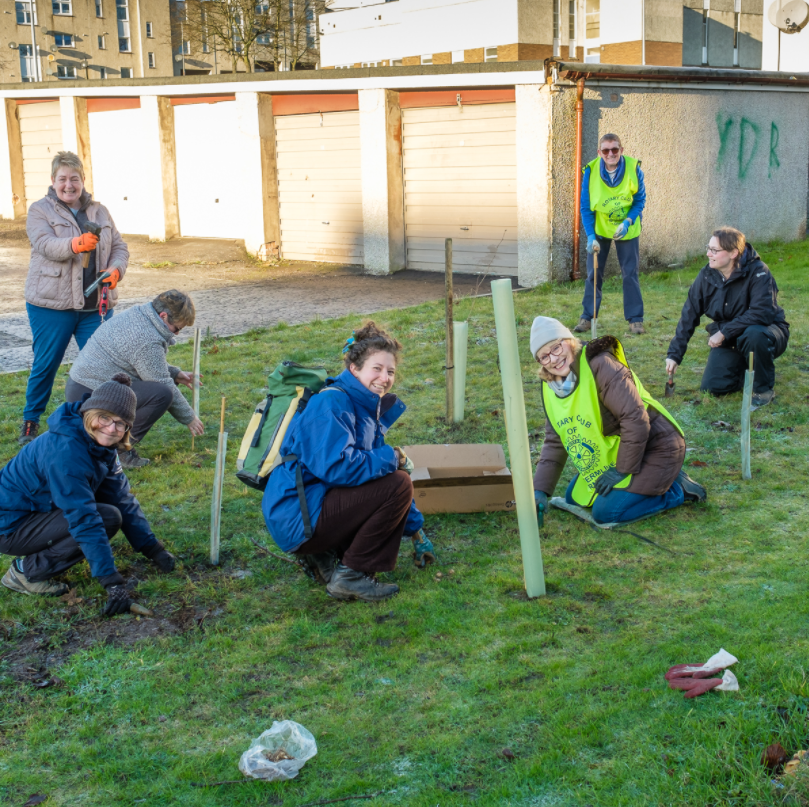The Lyne Burn Story
The Lyne Burn is a river which rises to the northeast of Dunfermline and travels southwest, eventually joining the Firth of Forth.
The Lyne Burn Green Network refers to a vision of improving and connecting the three areas of greenspace at Rex Park, Lyne Burn Park, and Touch in central Dunfermline to create a green corridor for people to use for recreation, active travel, and play.
Dunfermline itself is steeped in history. Dunfermline Abbey is the burial place of many of Scotland’s kings and queens including King Robert the Bruce.
The three areas are home to history and heritage themselves. At the top of Lyne Burn Park you pass by groups of trees planted in squares – these are the Woodmill bleachfields where historically linen would have been bleached and left to dry. Mining is also a part of the town’s history, with part of Lyne Burn Park having once been a limestone quarry. The surrounding area includes Garvock Hill, where a single forest once provided timber enough to rebuild the whole of Dunfermline when the town was lost to fire.
Project Aims
The Lyne Burn Green Network Project:
- Restoring a 453m length of artificially straightened channel of the Lyne Burn to a more natural condition.
- Improving the quality of greenspaces by planting trees, orchards, wildflower areas and hedgerows with the community.
- Creating a community growing space.
- Installing natural play areas.
- Engaging local school children and community groups in activities and practical conservation initiatives.
- Installing a cycle path following the Lyne Burn and allowing for safe and green travel along the riverside.
River Restoration
In May 2021 work on the restoration of the burn which runs through Rex Park began. This work was funded by SEPA’s Water Environment Fund meeting obligations under the Water Framework Directive.
The straightened channel will be restored to natural meanders, thereby improving climate resilience, and providing better habitat for wildlife including fish, birds, and mammals such as otters and bats.
Green Infrastructure
Following on from the river restoration, landscaping works will be undertaken to improve the green corridor, by planting trees, orchards and create wildflower meadows to improve the quality of the greenspace for people and wildlife. These new, attractive spaces will provide important habitat for pollinators like butterflies and bees.
Our pollinators are in serious national and international decline. Creating new habitats for these insects is a key aim of the Fife Local Biodiversity Action Plan (LBAP). By creating habitat, we are not only making a difference locally along the Lyne Burn Green Network, but also contributing to regional, national and international conservation efforts for our wildlife.
Community Engagement
Whilst a key aim of this project is improving and connecting the greenspace across Rex Park, Lyne Burn Park, and Touch, we are also looking to connect the communities around them. Through a series of events, workshops, and community meetings we saw the community’s vision is brought to life.
Starting in 2022 a programme of tree and bulb planting began, with community groups, businesses, schools and individuals getting involved. Over the next two years further planting took place, at every stage the community had a say in the plans for the area, so they had a played an important part in creating a local living legacy.
In 2023 Community engagement activities included further tree and bulb planting, before further tree planting, a litter pick and bird survey rounded in 2024. A Lyne Burn day was held in April 2024 to celebrate the formal end of the project.
Going forward the Touch Community Garden will continue to encourage the local community to look after the Lyne Burn as this place continues to grow, creating a special outdoor space for the people of the City of Dunfermline.
Award Winning Project
The Lyne Burn Green Network was recognised in the Scottish Design Awards 2024, in the Public Realm/Landscaping Category, winning a silver award. The success of the scheme is a result of intense and ongoing partnership working between SEPA, Fife Council, Fife Coast and Countryside Trust, Dunfermline Play and Grow (now Touch Community Garden), local residents, businesses, and the consultant team. This collaboration led to a successful implementation with buy-in and participation of the local community, addressing the climate, biodiversity, and health crisis, which resulted in limited vandalism, increased volunteering and events, social spaces and the community garden offering a variety of opportunities for activities.























